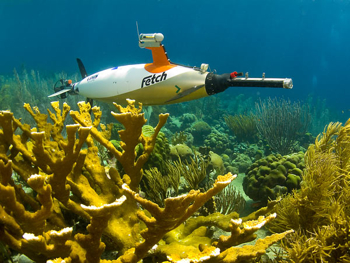Bonaire
In January 2008, NOAA's Office of Ocean Exploration provided funding to the Virginia Insitute of Marine Science's Autonomous Systems Lab (ASL) to explore coral-reef sustainability on Bonaire's pristine reefs using the autonomous underwater vehicle Fetch.
Bonaire, one of the islands of the Netherlands Antilles, is arguably the most pristine coral-reef environment in the Caribbean, with a higher percent of coral cover—and a lower percent of algal cover—than any other Caribbean island. Thus, the Bonaire reef environment represents a relatively untrammeled baseline against which to compare other coral reefs.
During the project, the ASL team, including VIMS graduate student Noelle Relles, used Fetch to collect video transects of Bonaire's reef, which she is now analyzing for percent coral cover and species diversity and statistically comparing to a reef atlas of Bonaire completed in the 1985 by Dutch scientist Dr. Fleur van Duyl.
Fetch allowed the ASL team to survey this unique environment over a greater depth range than could be reached with compressed air SCUBA. Mapping of the biological and physical environment documented patterns of biodiversity in both shallow and deep parts of the reef, and will provide an important resource for this island as it works to continue to protect the Bonaire Marine National Park (BMNP), one of the first and most effective attempts at marine preservation in the Caribbean.
Also participating on the project were scientists from the University of Delaware and the Scripps Institution of Oceanography. The Island Government of Bonaire, scientists at the National Oceanography Centre, United Kingdom, and two makers of underwater technology, Hafmynd and GeoAcoustics, also assisted.


